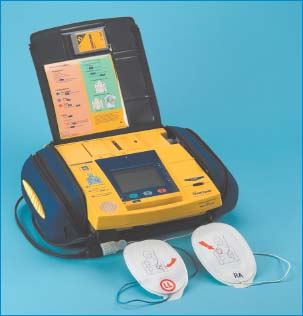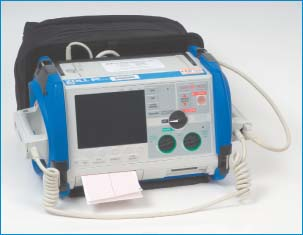Defibrillation
The standard treatment for ventricular fibrillation, defibrillation involves using external pads or paddles to direct an electrical current through the patient’s heart. The current causes the myocardium to depolarize; this, in turn, encourages the sinoatrial node to resume control of the heart’s electrical activity. This current can be delivered by a monophasic or biphasic defibrillator.
Defibrillators with monophasic waveforms deliver current in one direction (as shown below). Few monophasic defibrillators are being manufactured, but some are still in use. For monophasic defibrillation to be effective, a high amount of electrical current is required.
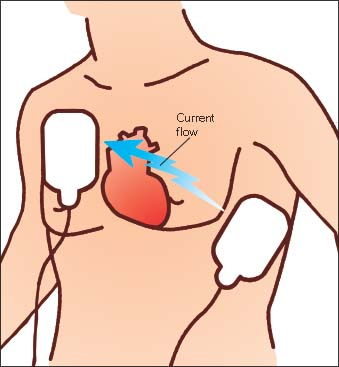 |
With biphasic defibrillation, the electrical current discharged from the pads or paddles travels in a positive direction for a specified duration and then reverses and flows in a negative direction for the remaining time of the electrical discharge (as shown on next page). It delivers two currents of electricity and lowers the defibrillation threshold of the heart muscle, making it possible to successfully defibrillate ventricular fibrillation with smaller amounts of energy. The biphasic defibrillator can adjust for differences in impedance or the resistance of the current through the chest. This helps reduce the number of shocks needed to terminate ventricular fibrillation. Biphasic technology uses lower
energy levels and fewer shocks, thus reducing the damage to the myocardial muscle. Biphasic defibrillators, when used at the clinically appropriate energy level, may be used for defibrillation and, when placed in the synchronized mode, may be used for synchronized cardioversion.
energy levels and fewer shocks, thus reducing the damage to the myocardial muscle. Biphasic defibrillators, when used at the clinically appropriate energy level, may be used for defibrillation and, when placed in the synchronized mode, may be used for synchronized cardioversion.
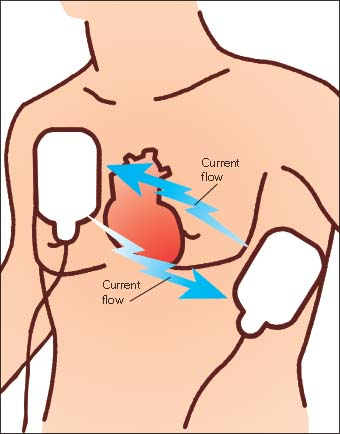 |
The external (hands-off) pads delivering the current are placed on the patient’s chest. Paddles may be used directly on the chest using conductive defibrillation pads, or, during cardiac surgery when the patient’s chest is open, sterile defibrillation paddles may be placed directly on the myocardium. (See Using a defibrillator.)
Using the self-adhesive (hands-off) defibrillation pads has been shown to be as effective as paddles, with the advantage of being convenient and safe, and allow rapid delivery of a shock, if necessary. They can also be used for monitoring and are recommended for routine use, if available, instead of paddles.1
Patients with a history of ventricular fibrillation may be candidates for an implantable cardioverter-defibrillator (ICD), a sophisticated device that automatically discharges an electrical current when it senses a ventricular tachyarrhythmia. (See Understanding the ICD, page 226.)
Equipment
Gloves ▪ defibrillator with electrocardiogram (ECG) monitor and recorder ▪ self-adhesive defibrillation pads and connector cable or defibrillation paddles with conductive gel, or prepackaged gelled conductive pads ▪ bag-mask device with mask and oxygen delivery equipment ▪ emergency suction and intubation equipment ▪ blood pressure monitoring equipment ▪ pulse oximeter ▪ IV infusion pumps.
Preparation of Equipment
Connect the defibrillation pads or paddles to the defibrillator and check that the defibrillator battery is adequately charged or the defibrillator electrical cord is plugged into the wall. Ensure that resuscitation equipment and medications are immediately available.
Implementation
Confirm the patient’s identity using at least two patient identifiers, according to your facility’s policy.7
If time allows, make sure the patient and family understand the procedure.
Put on gloves and follow standard precautions throughout the procedure.8
Assess the patient to determine that he’s unresponsive and not breathing (or only gasping).3
If the patient is unresponsive and not breathing, call for help and then take up to 10 seconds to attempt to feel for a pulse (carotid or femoral). If you’re alone and don’t feel a pulse or you’re unsure whether you feel a pulse, begin chest compressions. After 30 compressions, open the patient’s airway using a head tilt–chin lift and give two breaths. If there is evidence of trauma that suggests spinal injury, use a jaw thrust without head tilt to open the airway. Continue cardiopulmonary resuscitation (CPR) until the defibrillator and emergency equipment arrive.3
Nursing Alert
Remove any transdermal medication patches from the chest (and back if using anteroposterior placement) and wipe the area clean, if possible, because the medication may interfere with the conduction of the current or produce a chest burn.3
Defibrillation Using Self-Adhesive Defibrillation Pads
Nursing Alert
If the patient is wet, dry the chest quickly before attempting to apply self-adhesive defibrillation pads to prevent inappropriate conduction of electrical current.3
Nursing Alert
Remove metallic objects that the patient may be wearing because they are excellent conductors of electrical current and could cause a burn.3
Expose the patient’s chest and apply the self-adhesive defibrillation pads.
For anterolateral placement, position one pad to the right of the upper sternum, just below the right clavicle, and the other over the fifth or sixth intercostal space at the left anterior axillary line (as shown on next page top).
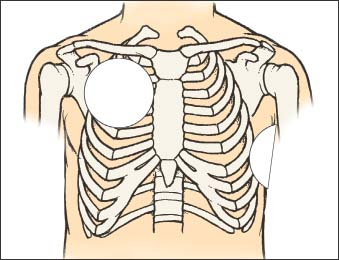
For anteroposterior placement, position the anterior pad directly over the heart at the precordium, to the left of the lower sternal border (as shown below, top illustration). Place the posterior pad under the patient’s body beneath the heart and immediately below the scapula but not on the vertebral column (as shown below, bottom illustration).
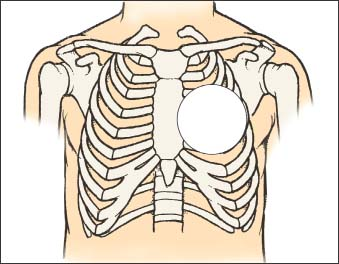
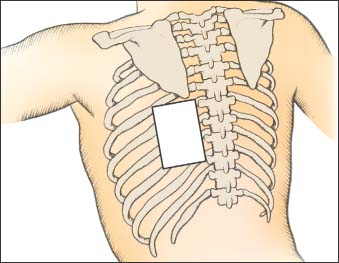
Using A Defibrillator
Because ventricular fibrillation leads to death if not corrected, the success of defibrillation depends on early recognition and quick treatment of this arrhythmia.2 In addition to treating ventricular fibrillation, defibrillation may also be used to treat ventricular tachycardia that doesn’t produce a pulse.3 To help treat your patient as quickly as possible, you should familiarize yourself with the defibrillator available at your facility. Use the defibrillators below as a guide to help familiarize yourself with the parts of a defibrillator.
Understanding the ICD
Stay updated, free articles. Join our Telegram channel

Full access? Get Clinical Tree


Get Clinical Tree app for offline access

